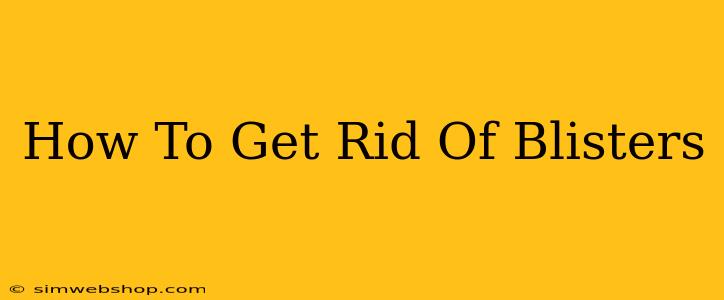Blisters. Those annoying, fluid-filled bubbles on your skin that appear after friction, burns, or allergic reactions. They can be incredibly painful and disruptive, especially if they're on your feet. But don't worry, getting rid of blisters doesn't have to be a painful process. This comprehensive guide will walk you through the best ways to treat and prevent blisters, ensuring you can get back to your activities quickly and comfortably.
Understanding Blisters: Types and Causes
Before we dive into treatment, it's helpful to understand what causes blisters in the first place. Blisters form when the skin's upper layers separate from the lower layers, creating a pocket that fills with fluid. This fluid, typically serum, acts as a protective cushion for the underlying skin.
There are several types of blisters:
- Friction blisters: These are the most common type, caused by repeated rubbing or friction against the skin, often from ill-fitting shoes, new equipment, or prolonged activity.
- Burn blisters: These result from exposure to heat, chemicals, or sunlight. They can be more severe than friction blisters.
- Allergic blisters: These are caused by an allergic reaction to a substance that comes into contact with your skin.
How to Treat Blisters: A Step-by-Step Guide
The best course of action for treating a blister depends on its size and severity. For small, intact blisters, the best approach is often to leave them alone. The blister acts as a natural bandage, protecting the underlying skin. However, if the blister is large, painful, or broken, you'll need to take extra steps.
Treating Intact Blisters:
- Leave it alone: Resist the urge to pop it! This can introduce bacteria and increase the risk of infection.
- Keep it clean and dry: Gently wash the area with mild soap and water, then pat it dry.
- Protect it: Cover the blister with a clean bandage to prevent further friction and irritation. Consider using a hydrocolloid bandage, which helps to cushion the area and promote healing.
Treating Broken Blisters:
- Clean the area: Gently wash the area with mild soap and water.
- Apply antibiotic ointment: This helps to prevent infection. Neosporin or similar ointments are effective.
- Cover it with a bandage: This will protect the wound and help it heal. Change the bandage regularly to keep it clean and dry.
- Keep it elevated (if on a limb): Elevating the affected area can help reduce swelling and pain.
When to See a Doctor:
While most blisters heal on their own, you should seek medical attention if:
- The blister is very large or deep.
- The blister shows signs of infection (increased pain, redness, swelling, pus).
- The blister is on your face or near your eyes.
- You have diabetes or another condition that affects healing.
Preventing Blisters: Proactive Measures
Preventing blisters is much easier than treating them. Here are some practical tips:
- Wear properly fitting shoes: This is the most important step! Shoes that are too tight or too loose can cause friction and blisters.
- Use moisture-wicking socks: These socks help to keep your feet dry and reduce friction.
- Lubricate your skin: Apply petroleum jelly or other lubricating creams to areas prone to friction.
- Break in new shoes gradually: Don't wear new shoes for hours at a time right away.
- Protect your skin: Wear gloves when doing tasks that could cause blisters.
Conclusion: Back to Blister-Free Bliss
Blisters are a common nuisance, but with proper care and preventative measures, you can avoid them and treat them effectively when they do occur. Remember, cleanliness, protection, and patience are key to quick healing and a comfortable return to your normal activities. By following the steps outlined above, you can say goodbye to painful blisters and hello to blister-free bliss!

